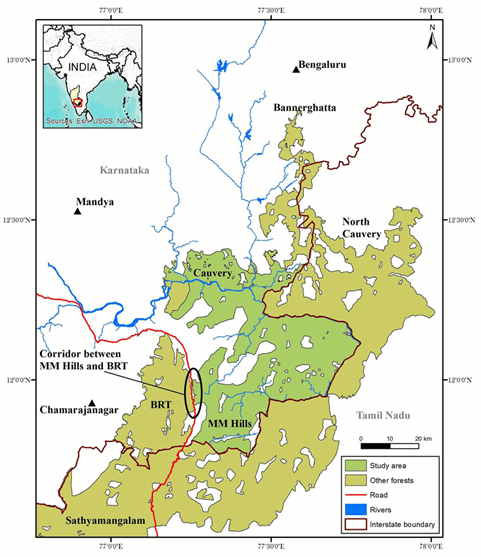- Courses
- GS Full Course 1 Year
- GS Full Course 2 Year
- GS Full Course 3 Year
- GS Full Course Till Selection
- Answer Alpha: Mains 2025 Mentorship
- MEP (Mains Enrichment Programme) Data, Facts
- Essay Target – 150+ Marks
- Online Program
- GS Recorded Course
- Polity
- Geography
- Economy
- Ancient, Medieval and Art & Culture AMAC
- Modern India, Post Independence & World History
- Environment
- Governance
- Science & Technology
- International Relations and Internal Security
- Disaster Management
- Ethics
- NCERT Current Affairs
- Indian Society and Social Issue
- NCERT- Science and Technology
- NCERT - Geography
- NCERT - Ancient History
- NCERT- World History
- NCERT Modern History
- CSAT
- 5 LAYERED ARJUNA Mentorship
- Public Administration Optional
- ABOUT US
- OUR TOPPERS
- TEST SERIES
- FREE STUDY MATERIAL
- VIDEOS
- CONTACT US
PLACES IN NEWS 27th June 2025
PLACES IN NEWS 27th June 2025

Male Mahadeshwara Hill WildLife Sanctuary

Why in the News?
- A tragic incident took place at the Male Mahadeshwara Wildlife Sanctuary in Chamarajanagar district of Karnataka.
- A tigress and her four cubs were found dead.
- This has caused serious concern among forest officials and wildlife lovers.
- The Karnataka Forest Minister has ordered a detailed investigation into the matter.
What are the Key Highlights?
- Name: Malai Mahadeshwara / Male Mahadeshwara Wildlife Sanctuary
- Location: Eastern Ghats, Chamarajanagar district, Karnataka
- Named After: Lord Male Mahadeshwara (temple located inside the sanctuary)
- Distance: 140 km from Mysore, 210 km from Bangalore
- Established: 2013
- Total Area: 906.187 sq. km (part of a larger 1,224 sq. km region)
- Status: Protected Wildlife Sanctuary; pending notification as a Tiger Reserve
- Geographical Importance:
- Lies near the tri-junction of Karnataka, Kerala, and Tamil Nadu
- Forms part of a contiguous tiger habitat
- Borders:
- North & East: Cauvery Wildlife Sanctuary (Karnataka)
- South: Sathyamangalam Tiger Reserve (Tamil Nadu)
- West: Biligiri Rangaswamy Temple Tiger Reserve (Karnataka)
- Flora:
- Dominated by dry and moist deciduous forests
- Faces ecological threat from Lantana invasion in many areas
- Fauna:
- Indian Elephant (Elephas maximus)
- Bengal Tiger (Panthera tigris tigris) – growing population since 2013
- Gaur, Wild boar, Indian leopard, Dhole
- Spotted deer, Barking deer, Sambar
- Four-horned antelope, Black-naped hare, Chevrotain
- Primates: Common langur, Bonnet macaque
- Other species: Honey badger
- Kollegal ground gecko (Cyrtodactylus collegalensis) discovered here in 2013
What are the Challenges and Way Forward?
|
Challenges |
Way Forward |
|
Lack of proper monitoring inside the sanctuary |
Increase use of camera traps, drones, and patrols |
|
Possible poisoning by locals or poachers |
Create strong community awareness and conduct regular outreach |
|
Delayed detection of unnatural deaths |
Install real-time wildlife tracking and improve response time |
|
Weak enforcement of wildlife protection laws |
Strengthen law enforcement and punish offenders strictly |
|
Inadequate staff and resources for forest departments |
Provide more staff, training, and equipment |
Conclusion
This heartbreaking event reminds us of how fragile our natural world is. Protecting wildlife requires constant attention, strict law enforcement, and strong community involvement. Every life lost is a signal to act faster and smarter in saving our forests and the creatures that live in them.
Palamu Tiger Reserve, Jharkhand

Why in the News?
- A wild male Bengal tiger entered a family's home in Mardu village, near Ranchi.
- The incident triggered a tense, hours-long rescue operation.
- The tiger, estimated to be a wild male aged around four to five years, was safely relocated to the Palamu Tiger Reserve (PTR).
- Palamau Tiger Reserve is one of India’s oldest tiger reserves.
- It is located in Jharkhand and is known for its rich biodiversity.
- It is one of the first nine tiger reserves launched under Project Tiger in 1973.
What are the Key Highlights?
- Location: Situated in Jharkhand; surrounded by Netarhat Forest (South), Auranga River (North), Latehar Forest Division (East), Garhwa Forest Division & Sarguja (West).
- Area: 1129.93 sq.km. It includes core area (414.08 sq.km) and buffer area (715.85 sq.km).
- Established: In 1973 under Project Tiger.
- Elevation: Ranges from 200 to 1700 meters above sea level.
- Rainfall: Average 1075 mm per year. The area is drought-prone due to the rain-shadow effect.
- Rivers: Watershed for Koel, Burha, and Auranga rivers.
- Terrain: Hilly and undulating with many streams and valleys.
- Climate: Tropical monsoon; summer temperatures may rise to 50°C, and winters can fall to 1°C.
- Soil Types: Nine different types including loamy, fine, skeletal, and coarse soils.
What is the Significance?
- It is one of the first tiger reserves in India and a model for scientific forest management.
- The first-ever tiger census using pugmark method was done here in 1932 by J.W. Nicholson.
- Acts as a key biodiversity hotspot in Eastern India.
- Home to important wildlife such as:
- Tigers, elephants, leopards, sloth bears, grey wolves, dholes
- 11 Schedule-I mammal species, 47 mammal species, 174 bird species
- 970 plant species, 56 medicinal plants, and 17 grass species
- Betla National Park (226.32 sq.km) lies within the core zone.
What are the Challenges and Way Forward?
|
Challenges |
Way Forward |
|
1. Frequent forest fires in the past |
Continue and improve fire management systems |
|
2. Past issues of poaching and grazing |
Strengthen anti-poaching laws and involve local communities |
|
3. Drought-prone area with water scarcity |
Build more waterholes and manage aquifers |
|
4. Invasion by non-native plant species (like climbers) |
Regular removal of invasive species and promote native flora |
|
5. Poor tourist infrastructure in buffer zones |
Develop eco-tourism with strict regulation |
|
6. Low awareness among local people about conservation |
Conduct education and outreach programs |
|
7. Need for better habitat restoration |
Increase grassland, soil, and moisture conservation activities |
Conclusion
Palamau Tiger Reserve is a natural treasure with deep historical, ecological, and conservation importance. With continued efforts in habitat protection, community engagement, and scientific management, it can serve as a model for other forest reserves in India and the world.



